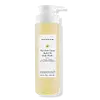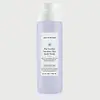What's inside
What's inside
 Key Ingredients
Key Ingredients

 Benefits
Benefits

 Concerns
Concerns

No concerns
 Ingredients Side-by-side
Ingredients Side-by-side

Glycerin
HumectantWater
Skin ConditioningCocamidopropyl Betaine
CleansingDisodium Cocoamphodiacetate
CleansingHippophae Rhamnoides Fruit/Seed Oil
AntimicrobialRosa Canina Fruit Oil
EmollientSimmondsia Chinensis Seed Oil
EmollientSqualane
EmollientPyrus Malus Fruit Extract
Skin ConditioningPolyquaternium-10
Maltodextrin
AbsorbentSorbitan Oleate Decylglucoside Crosspolymer
CleansingPhenoxyethanol
PreservativeCocos Nucifera Fruit Extract
EmollientVanilla Planifolia Fruit Extract
Skin ConditioningGardenia Jasminoides Fruit Extract
Cosmetic ColorantEugenia Caryophyllus Flower Extract
AstringentPrunus Armeniaca Fruit Extract
Skin ConditioningPrunus Persica Fruit Extract
AbrasiveCitric Acid
BufferingEthylhexylglycerin
Skin ConditioningTetrasodium Glutamate Diacetate
Glycerin, Water, Cocamidopropyl Betaine, Disodium Cocoamphodiacetate, Hippophae Rhamnoides Fruit/Seed Oil, Rosa Canina Fruit Oil, Simmondsia Chinensis Seed Oil, Squalane, Pyrus Malus Fruit Extract, Polyquaternium-10, Maltodextrin, Sorbitan Oleate Decylglucoside Crosspolymer, Phenoxyethanol, Cocos Nucifera Fruit Extract, Vanilla Planifolia Fruit Extract, Gardenia Jasminoides Fruit Extract, Eugenia Caryophyllus Flower Extract, Prunus Armeniaca Fruit Extract, Prunus Persica Fruit Extract, Citric Acid, Ethylhexylglycerin, Tetrasodium Glutamate Diacetate
Water
Skin ConditioningSodium Cocoyl Isethionate
CleansingHydroxypropyl Starch Phosphate
Cocamidopropyl Hydroxysultaine
CleansingGlycerin
HumectantCoco-Glucoside
CleansingSodium Methyl Cocoyl Taurate
CleansingAvena Sativa Kernel Flour
AbrasiveAloe Barbadensis Leaf Juice
Skin ConditioningCalendula Officinalis Flower Extract
MaskingPanthenyl Hydroxypropyl Steardimonium Chloride
Chamomilla Recutita Flower Extract
MaskingGlycol Distearate
EmollientAlthaea Officinalis Root Extract
Skin ConditioningCamellia Sinensis Seed Extract
HumectantPhenoxyethanol
PreservativeCocamide Mipa
EmulsifyingEthylhexylglycerin
Skin ConditioningTetrasodium Glutamate Diacetate
Saccharomyces Ferment Lysate Filtrate
Skin ConditioningCitric Acid
BufferingWater, Sodium Cocoyl Isethionate, Hydroxypropyl Starch Phosphate, Cocamidopropyl Hydroxysultaine, Glycerin, Coco-Glucoside, Sodium Methyl Cocoyl Taurate, Avena Sativa Kernel Flour, Aloe Barbadensis Leaf Juice, Calendula Officinalis Flower Extract, Panthenyl Hydroxypropyl Steardimonium Chloride, Chamomilla Recutita Flower Extract, Glycol Distearate, Althaea Officinalis Root Extract, Camellia Sinensis Seed Extract, Phenoxyethanol, Cocamide Mipa, Ethylhexylglycerin, Tetrasodium Glutamate Diacetate, Saccharomyces Ferment Lysate Filtrate, Citric Acid
 Reviews
Reviews

Ingredients Explained
These ingredients are found in both products.
Ingredients higher up in an ingredient list are typically present in a larger amount.
Citric Acid is an alpha hydroxy acid (AHA) naturally found in citrus fruits like oranges, lemons, and limes.
Like other AHAs, citric acid can exfoliate skin by breaking down the bonds that hold dead skin cells together. This helps reveal smoother and brighter skin underneath.
However, this exfoliating effect only happens at high concentrations (20%) which can be hard to find in cosmetic products.
Due to this, citric acid is usually included in small amounts as a pH adjuster. This helps keep products slightly more acidic and compatible with skin's natural pH.
In skincare formulas, citric acid can:
While it can provide some skin benefits, research shows lactic acid and glycolic acid are generally more effective and less irritating exfoliants.
Most citric acid used in skincare today is made by fermenting sugars (usually from molasses). This synthetic version is identical to the natural citrus form but easier to stabilize and use in formulations.
Read more about some other popular AHA's here:
Learn more about Citric AcidEthylhexylglycerin (we can't pronounce this either) is commonly used as a preservative and skin softener. It is derived from glyceryl.
You might see Ethylhexylglycerin often paired with other preservatives such as phenoxyethanol. Ethylhexylglycerin has been found to increase the effectiveness of these other preservatives.
Glycerin is already naturally found in your skin. It helps moisturize and protect your skin.
A study from 2016 found glycerin to be more effective as a humectant than AHAs and hyaluronic acid.
As a humectant, it helps the skin stay hydrated by pulling moisture to your skin. The low molecular weight of glycerin allows it to pull moisture into the deeper layers of your skin.
Hydrated skin improves your skin barrier; Your skin barrier helps protect against irritants and bacteria.
Glycerin has also been found to have antimicrobial and antiviral properties. Due to these properties, glycerin is often used in wound and burn treatments.
In cosmetics, glycerin is usually derived from plants such as soybean or palm. However, it can also be sourced from animals, such as tallow or animal fat.
This ingredient is organic, colorless, odorless, and non-toxic.
Glycerin is the name for this ingredient in American English. British English uses Glycerol/Glycerine.
Learn more about GlycerinPhenoxyethanol is a preservative that has germicide, antimicrobial, and aromatic properties. Studies show that phenoxyethanol can prevent microbial growth. By itself, it has a scent that is similar to that of a rose.
It's often used in formulations along with Caprylyl Glycol to preserve the shelf life of products.
Tetrasodium Glutamate Diacetate is a chelating agent. Chelating agents help prevent metal ions from binding to other ingredients. This helps prevent unwanted effects and reactions from a product. These metal ions may come from water and are found in miniscule amounts.
Tetrasodium Glutamate Diacetate can also help other preservatives be more effective.
Water. It's the most common cosmetic ingredient of all. You'll usually see it at the top of ingredient lists, meaning that it makes up the largest part of the product.
So why is it so popular? Water most often acts as a solvent - this means that it helps dissolve other ingredients into the formulation.
You'll also recognize water as that liquid we all need to stay alive. If you see this, drink a glass of water. Stay hydrated!
Learn more about Water